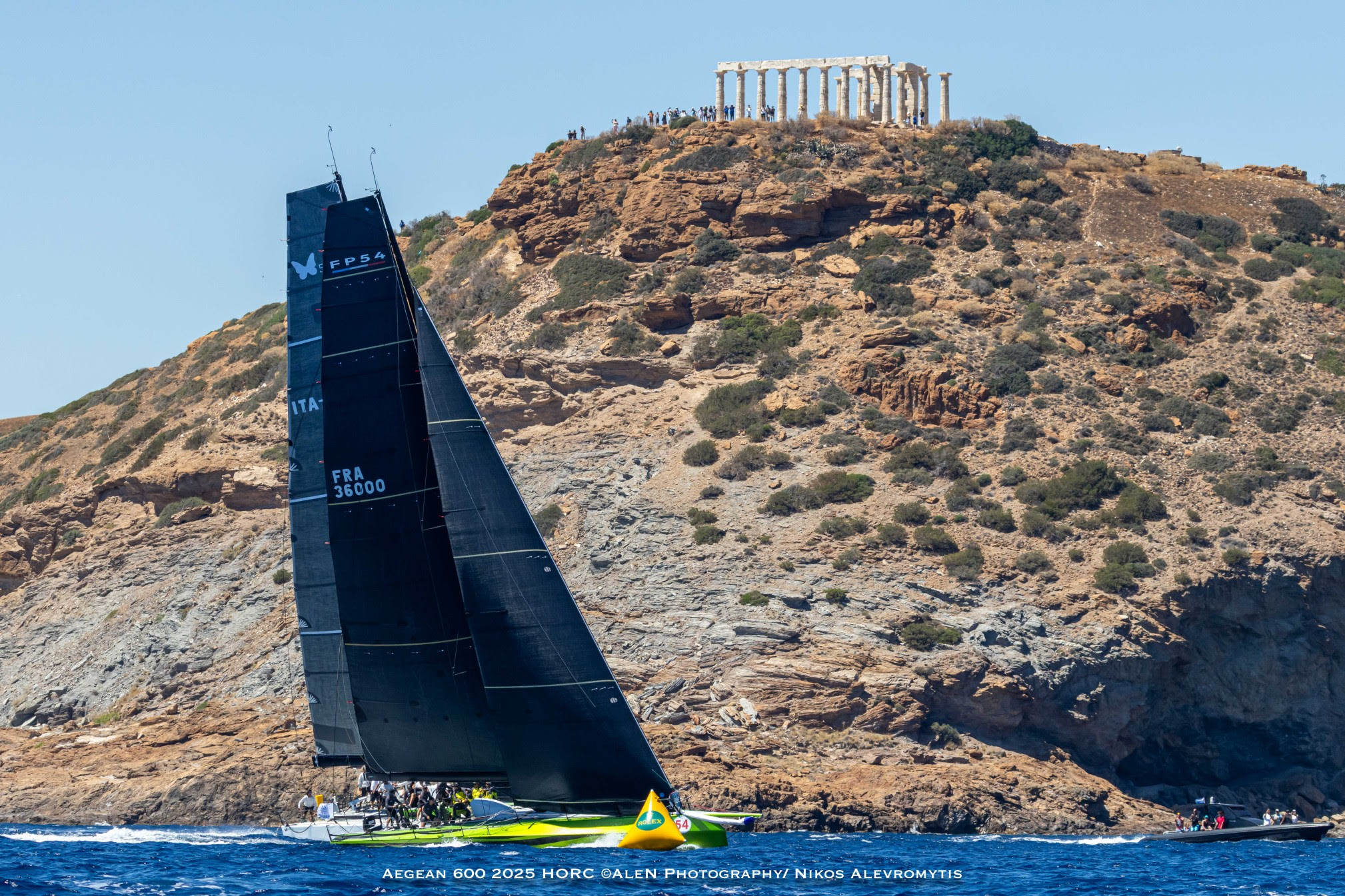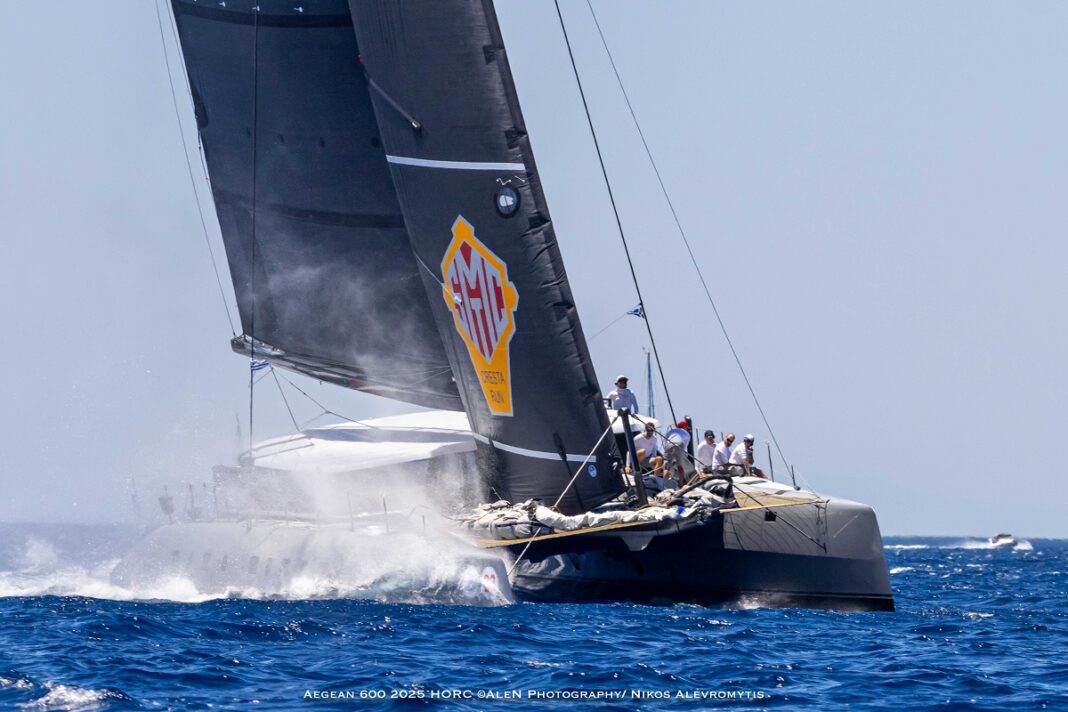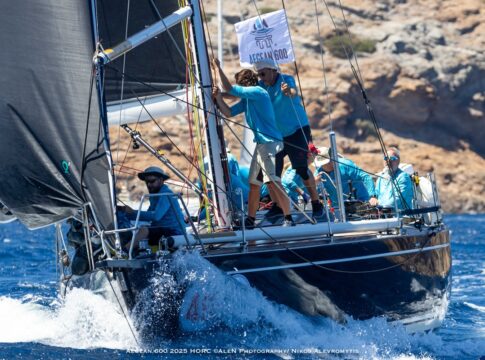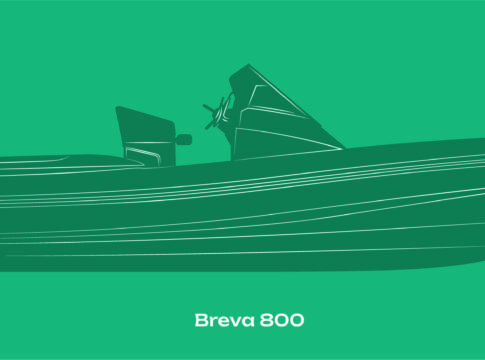If the previous two Aegean 600s were among the most brutal offshore races on record with storm force winds and violent gusts, conversely this year’s fifth edition of the anti-clockwise lap of the Aegean Sea was largely the lightest.
As usual the event, organised by Hellenic Offshore Racing Club and the Lavrion-based Olympic Marine, with Rolex as official timekeeper, was the sixth in the International Maxi Association’s annual Mediterranean Maxi Offshore Challenge.
During the race several boats pulled out what seemed unassailable leads only to fall into giant wind holes, many defying meteorological reason. Despite the race taking almost four days to complete, it culminated in an extraordinary three-way dash for line honours in survival conditions between a VO70, a smaller modern IRC racer and a maxi-catamaran.
Even for the start for the 59 boat fleet, including eight MOCRA multihulls and four maxi yachts, from Cape Sounion at 1400 on Sunday 6 July, the light wind forecast didn’t materialise. “We went out and straight away were flying a hull past Poseidon’s temple,” recounted Paul Larsen, co-skipper on Adrian Keller’s 84ft catamaran and line honours favourite Allegra.
Heading away from Lavrion, Allegra and Philip Rann’s Swan 80 Umiko did best, west of the rhumb line, leading into the first park-up early the first evening. Allegra was first to get away along with monohull line honours favourite and defending Maxi Class champion, the VO70 Aiolos campaigned by President of the Yacht Club of Greece George Procopiou, the event’s principal supporter.

Aiolos was first to the Milos turning mark just ahead of Allegra, whose crew then attempted to apply knowledge acquired during past Aegean 600s.
Larsen explained: “If you’re the first canary down the coalmine everyone can see what’s real and decide to go there or not. All the high res models were saying different things and the expected southwesterly just wasn’t filling in, so we decided to stick in behind Milos…but we got absolutely rinsed. We spent all night tacking in and out and looking at the same view each time…” They were passed by Umiko and Federico Marchi and Diego San Giuliano’s 69ft Nacira, and several smaller race yachts.
Another park-up occurred when the front runners reached the magnificent Santorini caldera the next afternoon. By this time the nimble new Carkeek 54 Daguet 5 had overtaken Aiolos with Allegra two and a half hours behind, just ahead of Nacira and Umiko. This caused further misery for the 32 tonne Allegra.
Larsen continued: “You sail into Santorini and park up. If you’re 100ft to the left or to the right you can just get stuck in these turbulent vortexes. All these other boats come rolling in, get a gust and go around you…”
When Allegra exited the caldera at 1730, Aiolos was 21 mile ahead having slowly overhauled Daguet 5, en route to the race’s southernmost point, Kassos. This Aiolos reached at 0100 on the second morning.
Being ‘first canary’ was soon to prove Aiolos’ undoing as she was becalmed off Karpathos, the next island past Kassos. Spotting this, Allegra had stayed offshore and recovered her deficit, but the lightweight Daguet 5 had found breeze shooting off towards Rhodes. This wind hole was the most significant of the race, catching all the race’s faster boats. By the time the restart occurred at 0730, Daguet 5 was 34 miles ahead.
Approaching Rhodes was the fastest part so far for Allegra, recalled Larsen: “We had an amazing power reach – full hull-flying, 25-28 knots, screecher up, full rig, just loving life, finally putting some good miles on the course.” The Swiss mega-cat was now back up to second, with Aiolos sixth close to other maxis E Vai, Umiko and Nacira.
Daguet 5 reached the easternmost turning mark off Rhodes harbour at 1400, with Allegra some 1 hour 30 minutes later with Aiolos 40 miles behind.
Sailing upwind west along the top of Rhodes to Kandelioussa, Allegra finally reeled in and passed Daguet 5, which was going around 9.5 knots to her 14. The big cat rounded this tiny island just after 2200 on day two, half an hour ahead of her French rival.

The passage anticlockwise around mountainous Kos is one of the trickiest parts of the race, but Allegra was prepared. They still experienced extreme wind sheer, Larsen explained: “There was this hot air coming through and it was like sailing in front of a hairdryer. Then it would cool again. At times you just couldn’t trust your wind instruments – they’d be saying the wind’s on the other side of the boat and yet your sails would be full.”
Allegra survived by maneouvring south towards the Datça Peninsula, and she rounded the eastern end of Kos at 0300 on 9 July, 7 miles ahead of Daguet 5. But conditions then turned light, again favoured Daguet 5 and as Allegra struggled past Farmakonisi, Daguet just got her nose ahead to reach the course’s northeasterly turning mark, Agathonisi, at midday on day three, 9 July.
As the leaders now attempted to make progress west upwind, they split tacks, Daguet 5 heading north towards Samos, Allegra going south, neither making good progress. Meanwhile the chasing group were busy reducing their deficit, reaching north to Agathonisi which Aiolos passed at 1445.
After turning their bows west, this group hugged the north coast of Agathonisi before shaving the northern tips of Arki and Patmos, Aiolos now up to third on the water. By 2200 Daguet 5 was making better progress to the north having shaved the western tip of Icaria, while Aiolos had caught up and passed the still wallowing Allegra.
Approaching Mykonos, after almost four days of mostly light winds, the notorious Meltemi arrived. Fortunately this was well forecast although the 35 knots forecast meant 50 in reality. Daguet 5’s northerly route had paid and at 0430 on 10 July she was first to Mykonos, with Aiolos 12 miles behind in second followed closely by Varuna and Allegra.
In the lee of Mykonos Allegra was already under two reefs and J2, making 12-18 knots and closing on Daguet 5 was making just seven. Into the Mykonos channel, they saw 49 knots. “We were pushing it along,” Larsen recalls. “We came off one big wave in a squall and the J2 pumped, went slack and split in half.” They changed to their J3, which we’ve never used before.
The last but one island of the course, Gyaros, provided a defining moment of the race as the three dissimilar yachts Daguet 5, Allegra and Aiolos approached it, now abreast, all hunting line honours. Remarkbly Argo had gained to its lee in 2024, a tactic Allegra followed this year, as Aiolos and Daguet passed to windward.
“When we got behind it, it was white with all these huge swirling eddies coming down off the cliffs, hitting the water and exploding out,” Larson recounted. “I was thinking we should get Adrian [Keller, owner] below. But he was loving it, because we were hammer down in what was otherwise survival conditions, the finish getting closer with all to play for…”

But the boats to windward this year gained. In ‘her’ conditions the VO70 Aiolos was able to nose in front leading around the top of Kéa and from there on the short fetch to the finish, first home at 09:32:08. Owner George Procopiou commented: “(Onboard Aiolos) it was an excellent regatta, with many changes of sails and a lot of competition from the other boats.
The weather was a big surprise for us as well: to have five days of calm in the Aegean… But the last 18 hours compensated us because we saw some 50 knots and this is where the whole game developed.”
At this point Allegra had backed off, resigned to finishing third, until they noticed Daguet 5 having problems. In fact despite having seen a prolonged period of 60 knots, that had relieved them of their masthead wind instruments, they were now becalmed. Thus Allegra sailed through them and, despite losing her hydraulics, kept her sails sheeted, crossing the line second at 09:59:54 with Daguet 5 third at 10:08:16.
Larsen continued: “At the end we were going ‘that was one of the best races we’ve ever had’: just high octane blasting. Everyone had had the same misery and had had to pay their tax. The course was the ultimate leveller and we ended up with three boats in line in a gale – all just going for it. Other races will feel boring after this.”
Ultimately Allegra’s 3 days 20 hours time was more than twice what the MOD70s had taken in 2024.
While Aiolos claimed line honours, an amazing result considering her mid-race deficit, overall it was Philip Rann’s Swan 80 Umiko which won Maxi class IRC honours on corrected time – a fine result for what could be Rann’s last race with her, (he has now acquired the Rogers 82 Aegir II). Umiko had an exceptional last quarter of the race, reaching west rather than upwind like the frontrunners. She shed her opponents to lead into the Mykonos channel and despite a final park-up off the northern tip of Syros, broke away again finishing eighth on the water.
“I would say, by some distance, it was the hardest 600 mile race I’ve ever done,” admitted Rann, who, as usual, sailed with a half amateur-half pro crew including North Sails’ Tommy Webb and former Clipper Round the World Race skipper Sean McCarter and co-skipper, Richard Gould. “We took a day and a half more than last year. But finally, we won something!”
Read Also: BEST BUDDIES from Germany are the winners of the AEGEAN 600 2025 edition
Of the race itself Rann added: “The wind stops for no reason and then starts without warning. We had 200 miles of gentle sailing and then 400 miles sitting in wind holes or getting smashed. We were getting 3m seas in places and quite short seas coming through as well. We also fell into a wind hole 32 miles from home, for no apparent reason…” A few hours earlier they had seen 44 knots, although light compared to the 72 they saw last year.
“It’s no country for old men,” Rann continued. “I’m 75 this year but the youngsters loved it, particularly when every third wave was coming over the boat. I prefer it when I’ve got a gin and tonic in my hand by 7pm!”
At Saturday night’s prizegiving, the George Andreadis Challenge Trophy for the highest placed IMA member was awarded to George Procopiou and the crew of Aiolos.





